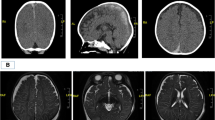Abstract
Arrhythmias occur as a life-threatening complication in adults with severe head injuries. A wide spectrum of brady- and tachyarrhythmias and different pathogenetic mechanisms have been described. We report an 8-year-old boy with traumatic brain injury who developed a variety of independent types of arrhythmias during the course of his illness, including supraventricular and ventricular extrasystoles, prolonged QT duration and ventricular fibrillation, accelerated junctional rhythm, and reentry tachycardia. Each arrhythmia may have had a distinct pathogenic pathway, and not all were associated with raised intracranial pressure.




Similar content being viewed by others
References
Andreoli A, Di Pasquale G, Pinelli G, et al. (1987) Subarachnoid hemorrhage: frequency and severity of cardiac arrhythmias. A survey of 70 cases studied in the acute phase. Stroke 18:558–564
Di Pasquale G, Pinelli G, Andreoli A, et al. (1987) Holter detection of cardiac arrhythmias in intracranial subarachnoid hemorrhage. Am J Cardiol 59:596–600
Goldstein B, Kempski MH, DeKing D, et al. (1996) Autonomic control of heart rate after brain injury in children. Crit Care Med 24:234–240
Jung F, Setzer M, Hohnloser SH (2001) Severe intracranial bleeding mimicking acute inferior myocardial infarction with right ventricular involvement. Cardiology 95:48–50
Keller C, Williams A (1993) Cardiac dysrhythmias associated with central nervous system dysfunction. J Neurosci Nurs 25:349–355
Randell T, Tanskanen P, Scheinin M, et al. (1999) QT dispersion after subarachnoid hemorrhage. J Neurosurg Anesthesiol 11:163–166
Wirth R, Fenster PE, Marcus FI (1988) Transient heart block associated with head trauma. J Trauma 28:262–264
Yamanaka O, Fujiwara Y, Nakamura T, et al. (1992) A case of subarachnoid hemorrhage with sick sinus and advanced AV block. Kokyu To Junkan 40:715–719
Zelikovic IN, Kaplan CB, Varsano IB, Aygen MM, Shalit MJ (1981) Precordial pain and electrocardiographic abnormalities simulating myocardial infarction associated with increased intracranial pressure in a child. Helv Paediatr Acta 36:483–487
Author information
Authors and Affiliations
Corresponding author
Rights and permissions
About this article
Cite this article
Grosse-Wortmann, L., Bindl, L. & Seghaye, MC. Multiple Types of Cardiac Arrhythmias in a Child with Head Injury and Raised Intracranial Pressure. Pediatr Cardiol 27, 286–288 (2006). https://doi.org/10.1007/s00246-005-1248-1
Published:
Issue Date:
DOI: https://doi.org/10.1007/s00246-005-1248-1




